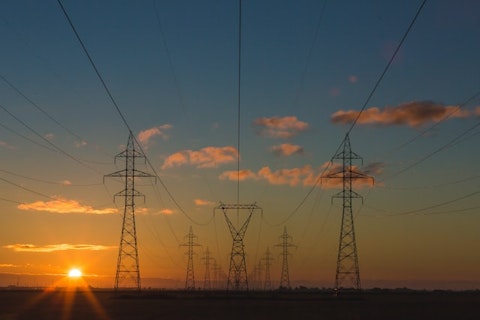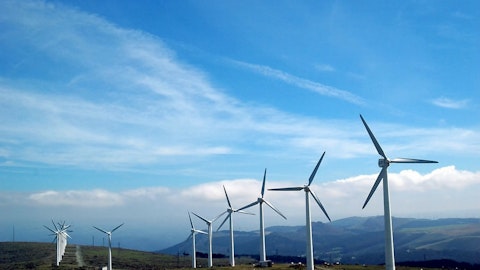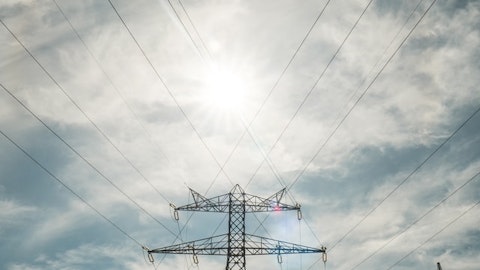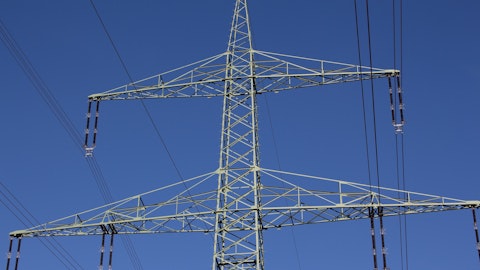American Electric Power Company, Inc. (NASDAQ:AEP) Q1 2023 Earnings Call Transcript May 4, 2023
American Electric Power Company, Inc. misses on earnings expectations. Reported EPS is $1.11 EPS, expectations were $1.12.
Operator: Ladies and gentlemen, thank you for standing by. Welcome to American Electric Power First Quarter 2023 Earnings Conference Call. At this time, your telephone lines are in a listen-only mode. Later, there will be an opportunity for questions and answers. [Operator Instructions] As a reminder, your call today is being recorded. I’ll now turn the conference call over to your host, Vice President of Investor Relations, Darcy Reese. Please go ahead.
Darcy Reese: Thank you, Alan. Good morning, everyone, and welcome to the first quarter 2023 earnings call for American Electric Power. We appreciate you taking time today to join us. Our earnings release, presentation slides and related financial information are available on our website at aep.com. Today, we will be making forward-looking statements during the call. There are many factors that may cause future results to differ materially from these statements. Please refer to our SEC filings for a discussion of these factors. Joining me this morning for opening remarks are Julie Sloat, our President and Chief Executive Officer; and Ann Kelly, our Chief Financial Officer. We will take your questions following their remarks. I will now turn the call over to Julie.
Julie Sloat: Thanks, Darcy. Welcome everyone to AEP’s first quarter 2023 earnings call. It’s good to be with everyone this morning. Our direction and strategy remain on track with an emphasis on our generation fleet transformation and continued investment in our energy delivery infrastructure, which is all embedded and our five-year $40 billion capital plan. I’ll start with an overview of our financial performance for the first quarter before discussing our Kentucky operations following the termination of our transaction with Liberty. I’ll then provide some updates on our unregulated contracted renewable sale, retail business review and other strategic plans before closing with some insight into our progress on the regulatory and legislative front as we work to implement important new initiatives to ensure our customers and communities’ needs are met and continue to come first, which you know enables us to deliver on our financial stakeholder commitments as well.
A summary of our first quarter 2023 business highlights can be found on Slide 6 of today’s presentation. We have a long-standing history of consistently delivering on our strategic objectives, and we’re pleased to share that this quarter is no different. Turning to a high-level overview of our financial results. I can tell you that AEP delivered first quarter 2023 operating earnings of $1.11 per share, or $572 million. Weather this quarter ranked as one of the mildest in the past 30 years resulting in an unfavorable impact of first quarter results. Despite this, our thoughtful and disciplined approach to managing the business enables us to reaffirm our 2023 full year operating guidance range of $5.19 per share to $5.39 per share, and with a $5.29 per share mid — $5.29 per share midpoint and long-term earnings growth rate of — growth rate range of 6% to 7%.
We’re confident in the built-in flexibility we have in our business to ensure that we successfully deliver on our financial commitments and continue AEP’s strong track-record of financial performance. We’re also pleased to report that AEP has experienced minimal financial and operational supply chain impacts to-date, primarily due to our successful efforts to diversify our mix of suppliers and increase our order quantities to minimize the impact on our robust capital investment plan. Ann I’ll walk through our first quarter performance drivers and share some perspective on our positive load outlook, as we continue to drive our economic development and service territory expansion. She’ll also review the drivers to support our targeted 14% to 15% FFO to debt range.
While our FFO to debt is at 11.4% this quarter, I am confident this metric will improve materially by year-end. As I mentioned to you on last quarter’s call, simplifying and derisking our business profile is one of our top strategic priorities. By actively managing our portfolio and demonstrating a clear commitment to a disciplined execution of initiatives and transactions, we continue to deliver significant benefits to our stakeholders. Actively managing our portfolio also means staying flexible and being ready to change our focus and adapt our strategy when it becomes clear that certain transactions or initiatives may no longer be viable. A few weeks ago, our team was faced with this very challenge. On April 17, we announced the termination of the sale of our Kentucky operations to Liberty.
Ensuring the best outcome for stakeholders remains our top priority and we took a disciplined approach to evaluating the continued pursuit of a sale and what that would mean in terms of economics, regulatory expectations, timing uncertainty. We ultimately determined that the better outcome was to terminate the pending sale transaction and to continue our work to develop a clear strategy for our Kentucky operations. I’m thankful for the team’s ability to react and adapt to shifting circumstances for the long-term benefit of our customers, employees and investors. After the termination of the sale, AEP met with the Kentucky commissioners and key stakeholders. We discussed Kentucky Power’s future and the collaboration needed so that we may continue to serve our customers in a reliable manner while ensuring the financial health and discipline of Kentucky Power moving forward.
In the near term, we’re renewing our focus on the region and support — and our support of the communities we serve. You’ll see in the earnings call materials today that Kentucky Power’s earned ROE for the 12-month period ending the first quarter of 2023 is 2.9%. This does not reflect a financially healthy utility, which needs to be resolved in consideration of the interest of all stakeholders. The underperformance is due in part to a number of unique issues that are and will be addressed for improvement over the course of the next year. As we think about the opportunities ahead for our Kentucky operations, the actions we will be engaged and include a refocus on economic development, enhanced local system reliability, and controlling customer cost.
We plan to file a base case in Kentucky in June with an expected six-month commission approval process, with new rates taking effect in January 2024. Other factors that will be beneficial in improving the financial profile and performance include using securitization to recover deferred storm costs and legacy generating plant balances and rightsizing the rate base. While we pivot in Kentucky, we’re focused on the successful execution of other key transactions. In February 2023, we announced an agreement with IRG Acquisition Holdings for the sale of our 1,360-megawatt unregulated renewables portfolio. A summary of the renewable sale can be found on Slide 7. All regulatory filings were made in March, and at this time, we’re waiting on approval from FERC under section 203 and clearance from the Committee on Foreign Investment in the United States and Euro Antitrust.
We already have cleared Hart-Scott-Rodino approval and China Antitrust. Consistent with our prior messaging, we expect the sale to close near the end of our second quarter 2023 depending on the timing of regulatory approvals. The proceeds from the transaction will be directed to our regulated businesses as we transform our generation fleet and enhance the electric delivery infrastructure. Furthering our commitment to simplify and derisk the company, and summarized on Slide 8, we’ve agreed with our joint venture partner PNM Resources to sell our portfolio of operating and developing solar projects in New Mexico. This 50/50 partnership is known as New Mexico Renewable Development, or NMRD. And we hold this within our unregulated operations portfolio, AEP.
NMRD owns eight operating solar projects totaling 135 megawatts, 150 megawatt project currently under construction and six development projects totaling 440 megawatts. Last week, an adviser was selected to move forward with the sale process. We anticipate making a sale announcement early in the fourth quarter of this year and will target closing by the end of 2023, subject to timing of regulatory approvals. We also have some news to share with you today. As you know, in October 2022, we announced the strategic review of our AEP Energy retail business, which primarily operates in the PJM markets. We’ve completed that strategic review and decided that we will start a sales process for that business and will also fold into the process AEP OnSite Partners, which is our unregulated distributed resources business.
We’ve hired an advisor to move forward, and we’ll keep you updated on the progress. We expect to launch the sale process sometime this summer, and we’ll update you with the details along the way, but currently expect the completion of this transaction in the first half of 2024. We’re focused on our core regulated utility operations and continue to evaluate all value additive potential activities to enhance their performance and look for opportunities to recycle capital. As a consequence of this effort, we’ve decided to pursue a strategic review of three of our non-core transmission joint venture businesses, including AEP’s interest in Prairie Wind Transmission, Pioneer Transmission, Transource Energy. These businesses total approximately $551 million in net plant investment for AEP and consists of 370 line miles and four substations of in-service assets, as well as various projects under development in PJM and SPP.
We’ll definitely keep you posted on our — or updated on our progress, but we expect to complete our review by the end of 2023 with a conclusion that consists of remaining in or divesting some or all of the businesses. So, let’s switch gears and talk about AEP’s regulated renewables execution. I’m pleased to share that we continue to make significant progress on our transition to a clean energy economy that provides more stable and predictable cost to our customers. Through our five-year, $8.6 billion regulated renewables capital plan, we have a total of $6.7 billion approved or before our commissions. Most recently, in March to be specific, we made regulatory filings for $1 billion of investment at INM, representing 469 megawatts of solar energy and another 151 megawatts of owned, wind, storage at owned and — owned, wind and storage at APCo for $466 million.
Public Service of Oklahoma Company along with other parties filed a settlement in early April of 2023 in the fuel-free power plan case, which relates to PSO’s 995.5-megawatt solar and wind portfolio for $2.5 billion. Like, in any other negotiation, this settlement we focused on the assurance of customer benefits without undue risk to the company. In this case, the settlement provided crucial capacity without fuel expense that’ll help address PSO’s large capacity need. The case took a positive step forward last week when the judge issued a preliminary opinion approving the settlement on April 27, and the commission has a case on its agenda for today, May 4. For SWEPCO’s 999-megawatt renewables project, which represents a $2.2 billion investment, parties recently filed an Arkansas settlement in January for these owned, wind and solar resources.
In another positive development in Texas, the administrative law judge that oversaw the evidentiary hearing issued the preliminary order which recommended project approval. And in Louisiana, we reached the settlement, however, we were disappointed that the Louisiana Commission did not approve the settlement on April 26, but we remain optimistic that the matter will be reconsidered at the next meeting this month. We look forward to the continued consideration in Louisiana and orders coming in Arkansas and Texas in the second quarter. It’s important to note that our regulated renewables goals are aligned and supported by our integrated resource plans, focused on reliability and customer affordability. In accordance with these plans, we have requests for proposals issued or preparing to be issued for additional resources at each of our vertically integrated utilities.
We plan to make related regulatory filings over the next year while taking into consideration commission preferences from previous RFP processes. Now, let me provide an update on several of our ongoing regular and legislative initiatives. We’re focused on reducing our authorized versus ROE gap. Have some work to do on that as our ROE was at 8.8% this quarter, driven in part by the unfavorable weather conditions that I mentioned earlier. On the effort to close the gap, I am happy to report that we reached the settlement and gained commission approval in January 23 — 2023 that closed out our SWEPCO Louisiana base case. A key to this case was the ability to reset rates and recover costs under a formula rate plan. And we have already put this into action as we filed under this provision last month.
Similarly, in April, AEP filed a formula rate review in Arkansas, which was authorized by that commission in the last base case. As we advanced through 2023, the team is actively pursuing rider recovery of the 88 megawatts of the Turk plant not currently in Arkansas rates. And the current base case in Oklahoma is set for hearing on May 9. So, we’re making progress on the regulatory front. We also worked closely with our stakeholders on the legislative front in Virginia to improve the former triennial rate case process. The new biennial rate process became law in April after active — after an active legislative session, APCo filed its last triennial in March of 2023 for the 2020 through 2022 period. The new law will require APCo to file its first biennial in 2024 with the biennial continuing in subsequent two-year period.

Photo by Matthew Henry on Unsplash
So, it’s going to work like this. The pending triennial will put rates in place for 2024 while we litigate the biennial in 2024 for rates effective in 2025, and we can help you with your modeling needs once we get a little further down the line here. Pivoting to our fuel cost recovery efforts for a minute. Our management of fuel cost recovery is a top priority for us with our total deferred fuel balance at $1.6 billion as of our first quarter. We adapted our fuel cost recovery across all of our jurisdictions with a focus on balancing customer impacts. In Texas, the commission approved the $83 million special fuel surcharge filed in October of 2022 and was being recovered subject to review since February 2023. So, making progress there. We are aware of the staff prudence filing last Friday, April 28 in West Virginia that recommended a disallowance of certain fuel costs.
The recommendation was rooted in the commission’s prior reference to a 69% capacity factor at our coal facilities. Prudence review is a report produced by an outside consulting firm hired by the staff. The report relies on factors beyond AEP’s control and takes issue with some of the practices taken to ensure that our power plants would have fuel available to provide electricity during the peak winter period. Those in the area are very familiar with how the historic swing of fuel cost over the past two years placed extreme pressure on the system and fuel recovery mechanisms. We advocated for the securitization legislation that recently passed in West Virginia knowing it provided an effective path to deal with those issues. In line with this strategy, APCo made a filing on April 28 seeking West Virginia Commission approval to utilize the new securitization tool to pay off the $553 million deferred fuel balance as February 28, 2023.
The filing also proposes to apply the mechanism to certain storm costs and legacy coal costs in a manner that minimizes cost impacts to customers while still addressing these historical costs. Related to the consultant’s prudence recommendation, the new APCo filing also lays out the environment APCo was operating in over this volatile fuel time or time in fuel cost and the actions taken to ensure coal would be available on the most extreme days on the system. Our plan is to collaborate with the commission to address customer and deferred fuel concerns together for constructive path forward in West Virginia. After receiving the commission approval, the plan would be to issue bonds to securitize a combination of deferred fuel balance, deferred storm costs, and legacy coal plan balances in the amount of $1.84 billion in the first half 2024.
So, wrapping it up, I’m pleased with the progress we’re making, capitalizing on our momentum from 2022. We continue to deliver on our commitments and execute against our strategic objectives. We’re taking a thoughtful and disciplined approach to simplify and derisk our business and investments we make to support our positive earnings growth and outlook. I proudly lead a team whose experience and expertise have made it possible for AEP to lay new groundwork for future success while also responding and adapting to the rapid changes we’re seeing in our industry. Together, we’re delivering safe, clean, affordable, and reliable energy to our customers and communities, all while creating values for our investors. With that, Ann — I will ask her to now walk through the first quarter performance drivers and provide us with some details on our financing targets.
So to you, Ann.
Ann Kelly: Thank you, Julie and Darcy. It’s good to be with you all this morning, and thanks for dialing in. I’m going to walk us through our first quarter results, share some updates on our service territory load and finish with commentary on credit metrics and liquidity, as well as some thoughts on our guidance, financial targets, and portfolio management. Let’s go to Slide 9, which shows the comparison of GAAP to operating earnings for the quarter. GAAP earnings for the first quarter were $0.77 per share compared to $1.41 per share in 2022. For the quarter, I’ll mention that we reflected the loss on the expected sale of the contracted renewables business as a non-operating cost, as well as an adjustment to true-up expected cost related to the Kentucky transaction in addition to our typical mark-to-market adjustment.
There’s a detailed reconciliation of GAAP to operating earnings on Page 15 of the presentation deck. Let’s walk through our quarterly operating earnings performance by segment on Slide 10. Operating earnings for the quarter totaled $1.11 per share or $572 million compared to $1.22 per share or $616 million in 2022. The lower performance was primarily driven by the unfavorable weather, as Julie mentioned. When looking at historical weather in the first quarter of the past 30 years, we’ve only seen one quarter with more mild weather than the first quarter of 2023. Operating earnings for our Vertically Integrated Utilities were $0.52 per share, down $0.07. Favorable drivers included rate changes across multiple jurisdictions, normalized retail load, off-system sales primarily associated with Rockport Unit 2, transmission revenue and depreciation.
I have more to share and load and performance, and we’ll get to that in a minute. These items were more than offset by unfavorable weather, higher O&M and income taxes largely related to timing differences between the years and interests. We expect the year-over-year interest variance to be more pronounced in the first half of the year, as interest rates have somewhat stabilized. We also expect to see favorable O&M in the second half of the year compared to prior year, reflecting the timing of O&M spending and near-term actions that we are taking to help offset the unfavorable weather, such as holding positions open, reducing travel and adjusting the timing of discretionary spending. These actions are in addition to our ongoing efficiency efforts that allow us to offset the impact of inflation each year.
I would like to take a second to talk about the off-system sales and depreciation. Due to the purchase of Rockport Unit 2 in December, we are seeing $0.05 of favorable off-system sales year-over-year since the margins are no longer shared with our retail customers. Also, due to the expiration of Rockport Unit 2 lease, I&M will see approximately $0.055 net favorable depreciation each of the first three quarters of 2023, plus an additional $0.035 in Q4. Including the impact of the Rockport lease, depreciation was $0.02 favorable versus the first quarter of last year. However, if you exclude the impact of the lease, depreciation would have been about $0.04 unfavorable, which is consistent with the incremental investment and a higher depreciable base in our Vertically Integrated Utilities segment.
The Transmission and Distribution Utilities segment earned $0.24 per share, down $0.06 compared to last year. Favorable drivers in this segment included rate changes from the distribution cost recovery factor rider in Texas and the distribution investment rider in Ohio, as well as transmission revenue. Offsetting these favorable items were unfavorable weather, unfavorable O&M largely due to higher distribution spending in the quarter, higher interest and lower normalized retail sales due to customer mix. The AEP Transmission Holdco segment contributed $0.35 per share, up $0.01 compared to last year, primarily driven by $0.02 of favorable investment growth. Generation & Marketing produced $0.09 per share, up $0.06 from last year. Favorable drivers here include a higher retail and wholesale power margins, favorable development site sales, depreciation, and taxes.
And finally, Corporate and Other was down $0.05 per share, largely driven by unfavorable interest. I’ll note that this is due to both an increase in interest rates as well as higher debt balances. I’d like to remind everyone that we reflected the higher interest rates in our guidance that we provided on our year-end 2022 earnings call. While the quarter was unfavorable to the prior year, we are taking actions to offset the unfavorable weather, including the O&M refinements that I just mentioned, that give us confidence to reaffirm our full year guidance range. Turning to Slide 11, I’ll provide an update on our normalized load performance for the quarter. We’ve continued to see load growth outperform when it’s proving to be a weak economy across our service areas.
This is most evident when comparing load performance across retail classes. So, we are seeing some weakness in residential loads. Our commercial and industrial classes are benefiting from new large customer volumes from our ongoing economic development efforts. This provides some potential upside to the full year outlook. Beginning in the upper left hand corner of the slide, normalized residential load was down as customers continue to be squeezed by the relationship between inflation and income growth. That relationship is a key driver of residential usage, and we expect to see it stabilize over the rest of the year. While we are seeing a decline in residential uses for customer, total residential customer counts were up by 0.5%, demonstrating growth in our service territory.
Looking through the rest of the slide, you’ll see that this was substantially offset by gains in our commercial and industrial loads attributable to new large customer additions. Normalized commercial sales accelerated an exceptional 7.8% compared to the first quarter of 2022. Though the growth in commercial sales was spread across many of our operating companies, gains were especially robust in AEP Texas and AEP Ohio, attributable to the new data center projects coming online in the new year. Outside of data centers, commercial gains were driven primarily by real estate, general merchandise stores, and food and drink establishments as individuals continue to move more freely in the wake of the pandemic. If we look to the lower left hand corner, we see the industrial sales resume their healthy pace of growth, increasing 5.1% from a year ago.
As with commercial sales, gains were most robust in AEP Texas, while SWEPCO also experienced double-digit growth in its industrial sales. Looking at individual sectors, gains are most pronounced among oil and gas extraction and primary metal. You’ll note that despite our strong commercial and industrial results for the first quarter, our expectations for 2023 load growth are still muted. Probability of a national downturn is extraordinarily high, and it’s clear that activity is already slowed to a point that it’s having a material impact on our customers’ finances. While we expect the pace of economic growth to slow further, we don’t anticipate a severe economic contraction across our service area in 2023. Though weaker than they were a year ago, household finances are still healthy by historical standards.
Furthermore, the labor market continues to be resilient in the face of Fed rate hikes, which will serve to limit the severity of a potential downturn. These assumptions have been baked into our full year guidance for some time allowing us confidence that our projected load growth for 2023 is very much achievable. Adding to that confidence is our believe that there is more upside to our load projections than downside, stemming from a disciplined commitment to economic development across our service area. We know that working with local stakeholders to attract more economic activity is a key strategy to providing value to our customers. This allows us to continue to prioritize investments that will improve the customer experience while mitigating the rate impacts on our customer base.
So, let’s move to Slide 12 to discuss the company’s capitalization and liquidity position. Taking a look at the upper left quadrant on this page, you can see our FFO to debt metric stands at 11.4%, which is a decrease of 1.8% from year-end and below our long-term target. The primary reason for this decrease is a $1.9 billion increase in balance sheet debt during the quarter, partially due to the return of the mark-to-market collateral positions associated with the decline in natural gas and power prices. Return of collateral also reduces our funds from operations, so it hits us on both sides of the equation. Without the fluctuations in our mark-to-market collateral positions, our FFP to debt metric will be closer to 13%. We expect that this metric will improve by year-end as we reduce debt after the close of the announced renewable sale and our 2020 equity units conversion, and our funds from operation improve over prior year, predominantly in the fourth quarter.
We remain committed to our targeted FFO to debt range of 14% to 15% and plan to trend back into this range early in 2024 as we continue to work through the regulatory recovery processes of our deferred fuel balances. You can see our liquidity summary in the lower left quadrant of the slide. Our five-year $4 billion bank revolver and two-year $1 billion revolving credit facilities that was just extended to March 2025 support our liquidity position, which remains strong at $3.4 billion. The $800 million increase in liquidity from last quarter is mainly due to a decrease in commercial paper outstanding from long-term debt issuances. On a GAAP basis, our debt to capital ratio increased from the prior quarter by 1.2% to 64.1%. We plan to trend back closer to 60% this year as we close our announced sale transaction and complete our previously planned equity units conversion.
On the qualified pension front, our funding status decreased 1.1% during the quarter to 101.3%. Rates fell during the quarter, which caused the pension discount rate to decrease, driving an increase in the liability that was greater than the gain on assets. Now turning to Slide 13. The first quarter has brought a significant challenge our way in the form of unfavorable weather. As we progress through the remainder of the year, we will continue to take action to manage our business and mitigate this impact. Our core business remains in a strong position and we are reaffirming our operating earnings guidance range of $5.19 to $5.39. We also continue to be committed to our long-term growth rate of 6% to 7%. As Julie previously addressed regarding the terminated Kentucky sale transaction, we are establishing a new — a renewed focus in long-term strategy in order to maximize the full potential of our Kentucky operations going forward.
We are on track to close the divestiture of our unregulated contracted renewables portfolio in the second quarter of this year, have announced the sale of our retail and distributed resources businesses, and are embarking on a review of some transmission joint ventures. These initiatives will help us to simplify and derisk our business while we continue to focus on the fundamentals, executing the $40 billion transmission, distribution and regulated renewables capital plan, disciplined O&M management and positive regulatory outcome. We really appreciate your time and attention today. And with that, I’m going to ask Alan to open the call so we can hear what’s on your mind and answer any questions that you have.
See also 20 Countries With the Most Skyscrapers and 30 Most Unstable Countries in the World.
Q&A Session
Follow American Electric Power Co Inc (NYSE:AEP)
Follow American Electric Power Co Inc (NYSE:AEP)
Operator: Thank you. [Operator Instructions] Our first question will come from the line of David Arcaro with J.P. Morgan. Go ahead.
Operator: We’ll go next to line of Jeremy Tonet with J.P. Morgan. Go ahead.
Operator: We have a follow-up question from the line of David Arcara with Morgan Stanley. One moment, please. Apparently, that line is not in queue. We’ll go next to the line of Shar Pourreza with Guggenheim Securities. Go ahead, please.
Operator: Our next question will come from the line of Durgesh Chopra with Evercore. Go ahead.
Operator: We’ll go next to the line of Andrew Weisel with Scotiabank. Go ahead.
Operator: We’ll now go to the line of Anthony — pardon me, Anthony Crowdell with Mizuho. Please go ahead.
Operator: We have a follow-up question from the line of Shar Pourreza with Guggenheim. Go ahead.
Operator: Our next question will come from the line of Sophie Karp with KeyBanc. Go ahead.
Operator: We’ll go now to the line of Julien Dumoulin-Smith with Bank of America. Go ahead.
Operator: We’ll go next to the line of Paul Fremont with Ladenburg. Go ahead.
Operator: We have a follow-up question from the line of Sophie Karp with KeyBanc. Go ahead.
Operator: We have a follow-up question from Paul Fremont with Ladenburg. Go ahead.
Operator: [Operator Instructions] We have a follow-up question from Paul Fremont with Ladenburg. Pardon me, that line did not open up. We have Bill Appicelli with UBS. Go ahead.
Operator: We have no further lines in queue at this time.
Darcy Reese: Thank you for joining us on today’s call. As always, the IR team will be available to answer any additional questions you may have. Alan, would you please give the replay information?
Operator: Thank you. Ladies and gentlemen, this conference will be made available for replay beginning today, May 4, 2023, at 11:30 a.m. Eastern Time through May 11, 2023, at midnight. During that time, you can access the AT&T Executive Playback service by dialing toll-free, 866-207-1041, internationally, you may dial area code 402-970-0847, and the access code is 2036342. Those numbers again are toll-free, 866-207-1041, internationally, area code 402-970-0847, and the access code 2036342. That will conclude your conference call for today. Thank you for your participation, and for using AT&T Event Teleconferencing. You may now disconnect.





